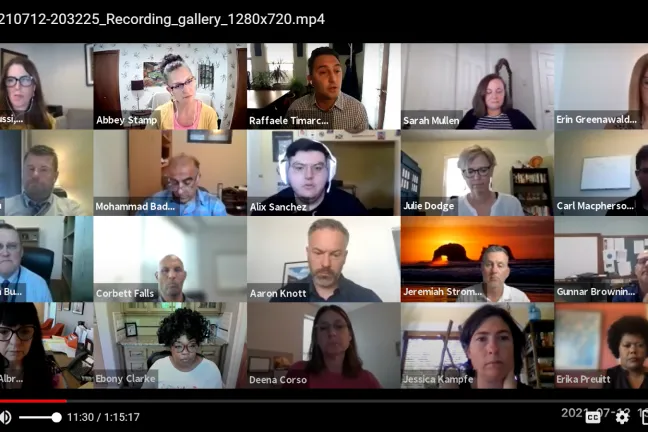Members of Multnomah County’s Local Public Safety Coordinating Council on Monday, July 12, received their first detailed briefing on important new investments this year that will help address community violence — specifically American Rescue Plan (ARP) funding meant to lift up community members in the wake of so many crises compounded by COVID-19.
Community violence continues to take an immense toll on community members. The violence takes shape in many forms, from youth violence, intimate partner violence, sexual violence, bullying, elder abuse and gun violence. And like so many other crises in the community, violence disproportionately impacts people from Black, Indigenous and other people of color (BIPOC) communities.
“We are one of the first jurisdictions in the country to use ARP funding for violence prevention,’’ said Raffaele Timarchi, a policy advisor to Multnomah County Chair Deborah Kafoury.
Timarchi said more than 1,000 individuals and organizations helped inform the Fiscal Year 2022 budget on community violence, which was crafted with core guiding principles. Those investments became available as of July 1.
At the forefront is inclusively leading with race, which is also a core value throughout Multnomah County. “We take a public health approach to violence prevention,” said Timarchi. “We know that gun violence disproportionately impacts BIPOC communities. And these proposals are intended to focus on serving those individuals.”
We also have a responsibility to take action to prevent violence and use evidence-based, community-centered, trauma-informed interventions — not only to prevent violence but also to address the impacts of trauma, both generational and recent, for survivors, for people involved in the criminal legal system, and for families and community members.
And finally, the budget recognizes the circumstances underlying current conditions and will “work to identify contributing factors and root causes of violence that the pandemic has exacerbated,” said Timarchi.
“We’ve known for a long time, even before the last year, that there’s a concentration of violence in communities with high rates of poverty, low-to-medium incomes, higher health disparities, higher eviction rates and less economic opportunities for residents,” he said.
Moving forward must include anti-poverty initiatives, emergency housing, trauma-informed therapy and drug treatment, school-based services, hunger relief, healthcare clinics and more, he stressed.
American Rescue Plan funds allowed the County to take a more focused approach to address these acute needs while also strengthening the County’s overall, system-wide response.
Funding was allocated in three major categories:
Strengthening Community,
Protecting Individuals and,
Safety and Healing
Strengthening Community
The budget included over $61 million of American Rescue Plan funding for violence prevention and safety net services — with $4 million in new and enhanced investments specifically to prevent and reduce gun violence.
“All of that is in addition to continued investments made to the County general fund,” Timarchi told the public safety council.
Investments in affordable housing and anti-displacement strategies — including $48 million in emergency rent assistance and $4.8 million in direct client assistance to help pay for a client’s most pressing financial needs, including food, childcare, transportation and living expenses — was also prioritized. Other investments include:
$1.1 million in to help community-based agencies expand their ability to provide public health services.
$300,000 for an incubator to encourage and foster growth among community providers providing gun violence intervention programming
$250,000 for neighborhood-focused gun-violence prevention forums in three distinct neighborhoods throughout the County.
Protecting Individuals
$300,000 to add Community Health Specialists in the Department of Community Justice. The specialists will also work with the Health Department and the Department of County Human Services to provide families with safety plans and offer trauma support to those who’ve been directly affected by gun violence.
$4 million for early childhood and family support to expand SUN Community School family navigator program.
$93,000 to help the Department of Community Justice’s Victim and Survivor Services Unit better support survivors of violence and their families.
Safety and Healing
$1.2 million to create a gun violence behavioral health response team — a specialized team of clinicians and peers that serves youth and families affected by gun violence.
$170,000 to FaithBridge Trauma Healing and Recovery Program, which supplements culturally specific opportunities for women emerging from trauma or life transitions and helps them to reconnect in a deep and meaningful way to faith. According to a Washington Post and Kaiser Family Foundation Poll, 87 percent of Black women, more than any other group, identified faith in helping them get through tough times.
$500,000 to expand Cognitive-Behavioral Therapy for legal-system-involved individuals, including an expansion in the Community Healing Initiative’s Elevate program.
$80,000 to expand the H.E.A.T. curriculum in the Department of Community Justice.
“We really focused on mental health and trauma recovery services and culturally rooted healing practices,” said Timarchi.
During the budget amendment process, the Board of Commissioners allocated $250,000 to build on community-based gun violence prevention work under way Northeast Portland’s Cully neighborhood, said Commissioner Susheela Jayapal.
“This is an effort to create a really hyper-local neighborhood coalition to bring community members together and think about the strategies that they would want to move forward,” she said. “It’s something that has been piloted in New York and Chicago and is moving forward as an effective community-based strategy.”
“This budget required a lot of cooperation,” said Timarchi, noting that Ebony Clarke, interim director of the Health Department and Erika Preuitt, director of Multnomah County’s Department of Community Justice helped shape a lot of this.”
“We tried to not only strengthen system responses but also build nimble interdisciplinary teams that would break down silos and give the tools of public health to everybody working in this field,” Timarchi said.
“There were lots of people and lots of good leadership that led to this budget.”

